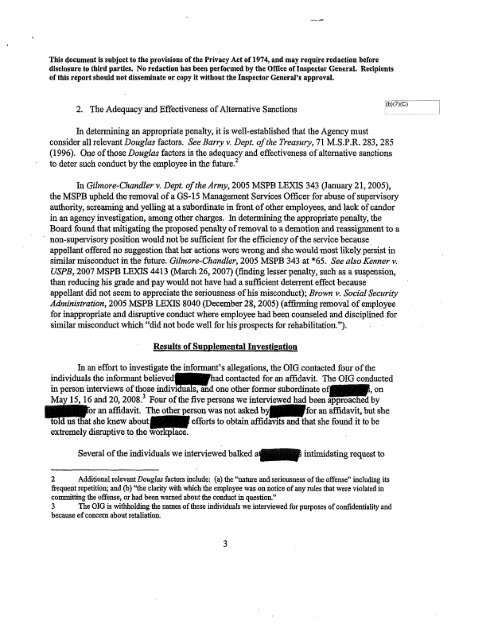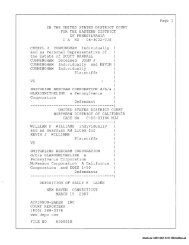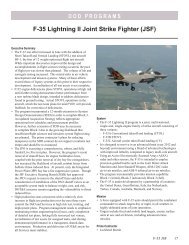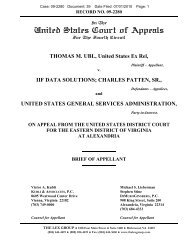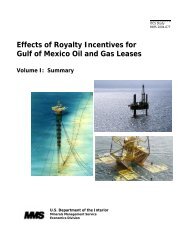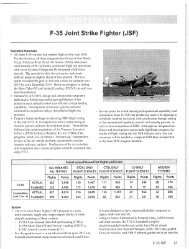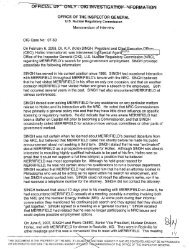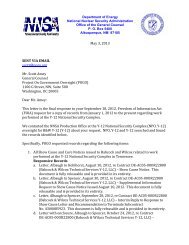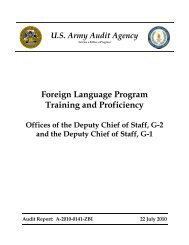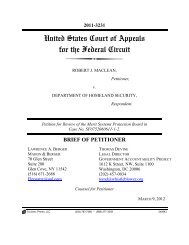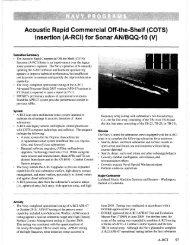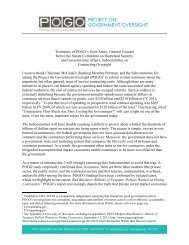Intimidating and Controlling Behavior
Intimidating and Controlling Behavior
Intimidating and Controlling Behavior
Create successful ePaper yourself
Turn your PDF publications into a flip-book with our unique Google optimized e-Paper software.
This document is subject to the provisions of the Privacy Act of 1974, <strong>and</strong> may require redaction before<br />
disclosure to third parties. No redaction has been performed by the Office of Inspector emeras. Recipients<br />
of this report should not disseminate or copy it without the Inspector General's approval.<br />
2. The Adequacy <strong>and</strong> Effectiveness of Alternative Sanctions<br />
In determining an appropriate penalty, it is well-established that the Agency must<br />
consider all relevant Douglas factors. See Barry v. Dept. of the Treasury, 71 M.S.P.R. 283,285<br />
(1 996). One of those Douglas factors is the adequacy <strong>and</strong> effectiveness of alternative sanctions<br />
to deter such conduct by the employee in the future.'<br />
In Gilmore-Ch<strong>and</strong>ler v. Dept. of the Army, 2005 MSPB LEXS 343 (January 21,2005),<br />
the MSPB upheld the removal of a GS-15 Management Services Officer for abuse of supervisory<br />
authorityy screaming <strong>and</strong> yelling at a subordinate in front of other employees, <strong>and</strong> lack of c<strong>and</strong>or<br />
in an agency investigation, among other charges. In determining the appropriate penalty, the<br />
Board found that mitigating the proposed penalty of removal to a demotion <strong>and</strong> reassignment to a<br />
non-supervisory position would not be sufficient for the efficiency of the service because<br />
appellant offered no suggestion that her actions were wrong <strong>and</strong> she would-most likely persist in<br />
similar misconduct in the future. Gilmore-Ch<strong>and</strong>ler, 2005 MSPB 343 at *65. See also Kenner v.<br />
USPB, 2007 MSPB LEXZS 4413 (March 26,2007) (finding lesser penalty, such as a suspension,<br />
than reducing his grade <strong>and</strong> pay would not have had a sufficient deterrent effect because<br />
appellant did not seem to appreciate the seriousness of his misconduct); Brown v. Social Security<br />
Administration, 2005 MSPB LEXIS 8040 (December 28,2005) (aEtirming removal of employee<br />
for inappropriate <strong>and</strong> disruptive conduct whae employee had been counseled <strong>and</strong> disciplined for<br />
similar misconduct which "did not bode well for his prospects for rehabilitation.").<br />
Results of Supi~lemental Investigation<br />
In an effort to investigate the informant's allegations, the OIG contacted four of the<br />
Individuals the informant believed ad contacted for an affidavit. The OIG conducted<br />
in person interviews of those indi one other former subordinate o , on<br />
May 15,16 <strong>and</strong> 20,2008,~ Four of the five persons we int by<br />
rson was not ask an affidavit, but she<br />
she found it to be<br />
extremely disruptive to .&e<br />
Several of the individuals we interviewed balked intimidating request to<br />
2 Additional relevant Douglas factors include: (a) the "nature <strong>and</strong> seriousness of the offense" including its<br />
fiequent repetition; <strong>and</strong> (b) %e clarity with which the employee was on notice of any rules that were violated in<br />
commitkg the offense, or had been warned about the conduct in question"<br />
3 The OIG is withholding the names of these individuals we interviewed for purposes of confidentiality <strong>and</strong><br />
because of concern about retaliation.<br />
W(7W


